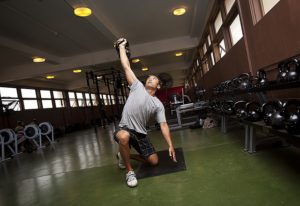When Your Back is Hurting
Fix the front.
Imagine your back, what image comes up? Lots of people visualize a spine.
The “back” of the spine in particular.
When our backs hurt we often try to fix where we feel pain.
We might try deep tissue massage, chiropractic, foam rollers, stretching, yoga, etc. to target the area in pain. Good posture and alignment sound logical. Purchasing a new bed might be in the plan.
Before you get too invested, try working on the front of your body.
What’s known as bad posture, I call anterior dominance meaning, the front of the body is overused. Overuse here means constantly contracted or drawn forward and down as in the fetal position.
Anterior dominance, and “fixing the front” is a new and different idea for most people, it’s important, and often missed . When the back of the body is hurting, the front is often thirsty for movements such as extension, length, arching, and rotation.
In healthy movement the front of the body and spine should move reciprocal to the back of the back of the body.
Here are some examples. First, a popular yoga pose. Look at the picture, what do you see in terms of the front/back relationship?
I see front and back balance. Both sides are equally working for length. I get a sense that things are “balanced.” Anything else?
Now, let’s put this idea into movement. Here’s a great example (click on his name) by Cameron Shane who does a great job mixing three of my favorite things: martial arts, yoga, and movement.
Now that you’ve got two examples and the idea is starting to take shape in your mind, a great question to start off with is, “Where or when am I not getting movement in the front of my body?” And “If you’re not then how can you?” Don’t encapsulate your movement into your exercise routine or your gym hour. What do you need to do during the day to often bring motion into your static posture, if you work at a desk, or if you do physical work are you limiting your movements to forward tasks and not lengthening and arching your front?
Don’t think this is going to come because you understand the idea, yes awareness is key, and developing body awareness is the first place to start, but follow that with self-care. Try to randomly catch yourself in the day where you’re either slouching (and ouching!) or tense and rigid from trying too hard to maintain “good posture.” Go past the vertical of uprightness.
As your awareness grows you’ll be able to hear your body calling out, and you can answer. For most people, even athletes, awareness is a skill that’s developed through practice. So train this into your day and into your body.
Lengthening the front is also a way of turning on the chemical cascade in the body and brain that rains down feel good hormones, confidence, and lowers cortisol (stress) levels.
Researcher Amy Cuddy has brilliantly given us what she calls, Power Poses and I like to feel the physiological responses she talks about, happen in real time (another exercise in awareness) so that I develop more confidence in the keys to my own physiology.
For my weightlifting friends out there in a culture where developing the posterior chain is popular for a number of good reasons, to the detriment of the anterior chain, here’s a link by Greg Everett owner of Catalyst Athletics and coach to the USA Weightlifting National Champion team. Greg says, “Balance, whether between posterior and anterior chains, or between strength and flexibility, will keep you functioning well rather than constantly bouncing between limitations and over-corrections.”
When I spend time “fixing the front” there are never any regrets. I feel better, stronger, more functional, free, and alive! Now it’s a part of every warm down routine and the next day I feel agile and limber from having broken the patterns of tension and use.
Try these out, make up your own, and tell me what you think!







